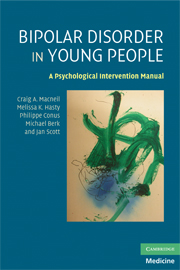Book contents
- Frontmatter
- Contents
- Preface
- Acknowledgements
- Introduction
- 1 Bipolar disorder
- 2 Assessment and engagement
- 3 Insight, adaptation, and functional recovery
- 4 Medication adherence
- 5 Cognitive behavioral therapy interventions
- 6 Social rhythm regulation
- 7 Relationship issues and family work
- 8 Alcohol, substance abuse, and other comorbid disorders
- 9 Identifying early warning signs, preventing relapse, and termination of therapy
- Appendices
- References
- Index
2 - Assessment and engagement
Published online by Cambridge University Press: 06 July 2010
- Frontmatter
- Contents
- Preface
- Acknowledgements
- Introduction
- 1 Bipolar disorder
- 2 Assessment and engagement
- 3 Insight, adaptation, and functional recovery
- 4 Medication adherence
- 5 Cognitive behavioral therapy interventions
- 6 Social rhythm regulation
- 7 Relationship issues and family work
- 8 Alcohol, substance abuse, and other comorbid disorders
- 9 Identifying early warning signs, preventing relapse, and termination of therapy
- Appendices
- References
- Index
Summary
The core of all treatments, biological and psychosocial, lies in the clinical relationship which develops between patients and professionals.
McGlashan et al. (1990, p. 182)Diagnostic difficulties in bipolar disorder
There is growing acknowledgement that bipolar disorder may be significantly underdiagnosed (Bowden, 2001). For example, Hirschfeld and colleagues' (2003) survey of over 600 members of the US National Depressive and Manic Depressive Association (now known as the Depression and Bipolar Support Alliance) found that 69% of people with bipolar disorder reported having been misdiagnosed at least once. Furthermore, over one-third of respondents had a latency period of at least 10 years between initially seeking help and receiving the correct diagnosis and treatment. Unfortunately there was little change in rates of misdiagnosis between this survey, in 2003, and when it was previously conducted in 1994.
Underdiagnosis and misdiagnosis in bipolar disorder result in part from its complexity and overlap of symptoms with other disorders. Unipolar depression appears to be the most common misdiagnosis, which is understandable as many individuals have 2 or 3 depressive episodes before they experience the first manic or hypomanic episode. Ghaemi et al. (2000a) reported that around 40% of people with bipolar disorder are initially misdiagnosed with unipolar depression, while Angst (2006) suggested that, using the broadest available criteria, between one-quarter and half of people diagnosed with unipolar depression may in fact meet the criteria for bipolar disorder.
- Type
- Chapter
- Information
- Bipolar Disorder in Young PeopleA Psychological Intervention Manual, pp. 21 - 35Publisher: Cambridge University PressPrint publication year: 2009



